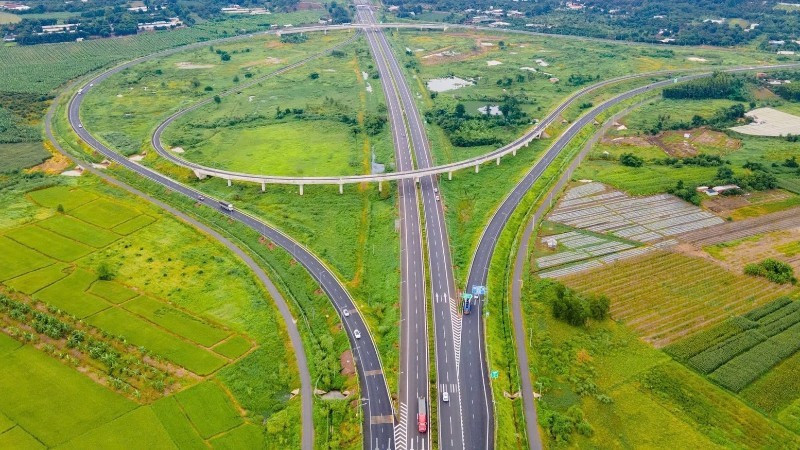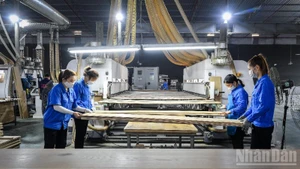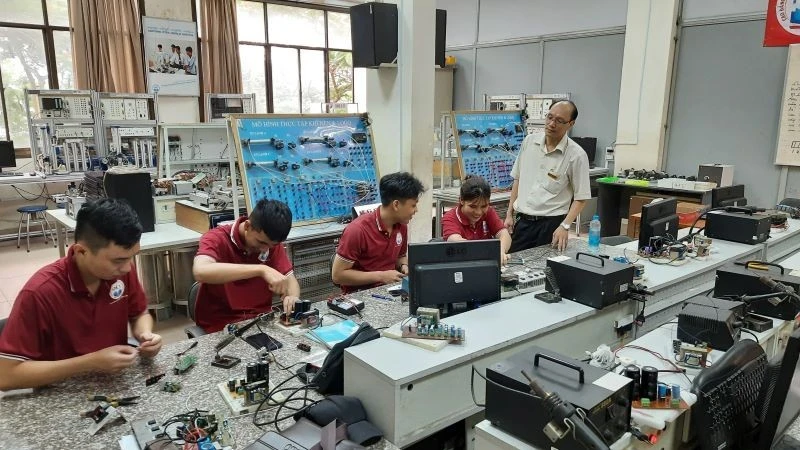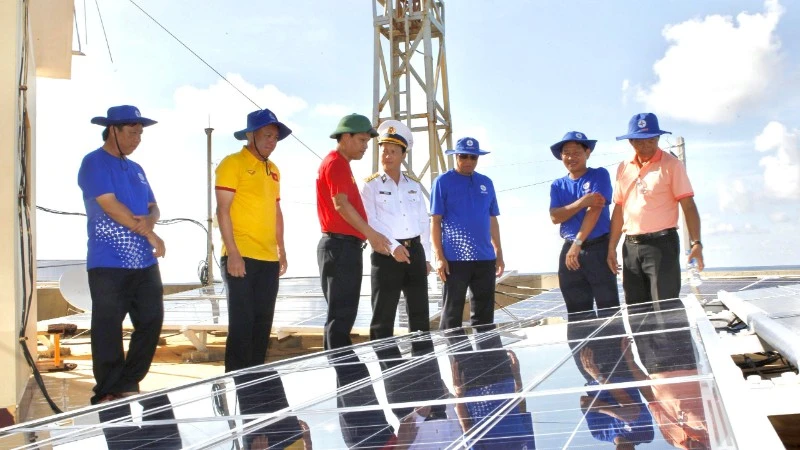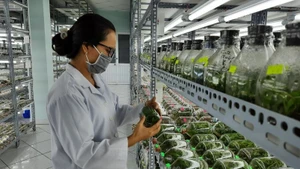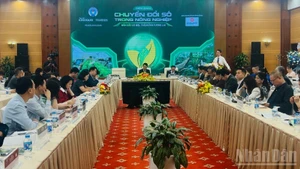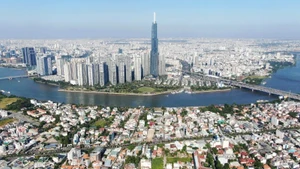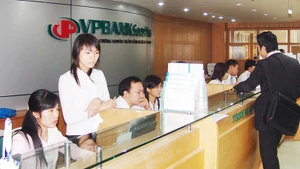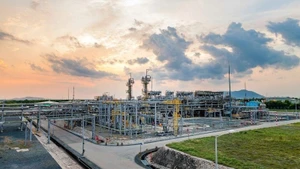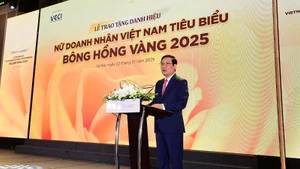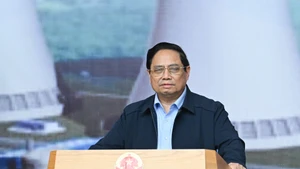He made the comment after recent inspections and meetings at key project sites to accelerate construction progress.
With that spirit, the Head of Government always urges every stakeholder and individual involved in projects to promote self-reliance and resilience, daring to think and act boldly in order to fulfil assigned tasks.
The great road opens, moving toward the future
People in the Mekong Delta still remember the Rach Mieu ferry across the Tien River – the lifeline connecting Tien Giang (now Dong Thap) with Ben Tre (now Vinh Long) – which was considered “the longest waterway crossing in Viet Nam”. In 2009, Rach Mieu 1 Bridge on National Highway 60 was put into operation. However, shortly afterwards, Rach Mieu 1 became overloaded and frequently congested.
In March 2023, construction officially began on Rach Mieu 2 Bridge, invested by the My Thuan Project Management Board. The bridge has a total investment of more than 6.81 trillion VND, 21.5 metres wide with four lanes, designed as a cable-stayed bridge with 112 cable bundles, and two main towers 113 metres high. The entire project was designed and built by Vietnamese engineers and workers, not only demonstrating creativity but also affirming Viet Nam’s mastery of science and technology.
After more than two years of construction, on August 19, thousands of residents eagerly gathered under the sun and wind to witness the inauguration, as the project was put into operation six months ahead of schedule. People expressed admiration for the bridge’s elegant, modern design, and spacious approach roads that make travel and sightseeing convenient.
Tran Tri Quang, Chairman of the People’s Committee of Dong Thap Province, expressed delight at the completion of this key transport project, meeting the long-standing expectations of people in the region who had suffered years of traffic congestion at Rach Mieu 1 Bridge.
Nguyen Hoang Binh, a container truck driver transporting fruit for Mekong Ben Tre Import-Export Company (Phu Tan Ward, Vinh Long), shared his happiness as Rach Mieu 2 Bridge was opened to traffic. On average, the company transports about 200 tonnes of goods weekly on more than 10 container trips. Previously, Rach Mieu 1 Bridge banned container trucks at certain hours, forcing drivers to start very early; however, if unexpected incidents along the way caused prolonged congestion, shipments missed their port schedules, resulting in significant losses.
According to economist Dr. Tran Huu Hiep, the inauguration of Rach Mieu 2 is not only the joy of millions of local people, but also a turning point in transport infrastructure for the entire Mekong Delta, helping ease the burden on Rach Mieu 1.
National Highway 60 has become a parallel axis to National Highway 1 and the Ho Chi Minh City–Trung Luong–My Thuan Expressway, linking between the Mekong Delta with Ho Chi Minh City’s seaports faster. On August 19, in Cao Bang, the second phase of the Dong Dang–Tra Linh Expressway project under the public–private partnership (PPP) model also commenced, extending more than 93 km from the first phase and adding nearly 26.5 km of new route (including 17 bridges and 3 mountain tunnels) to Tra Linh border gate, expected to be completed by the end of 2027.
Ho Minh Hoang, Chairman of Deo Ca Group – the investor and general contractor of the project, said that once completed, the two phases of Dong Dang–Tra Linh, together with Huu Nghi–Chi Lang and Bac Giang–Lang Son projects, will form a strategic transport corridor linking Ha Noi to Cao Bang, opening development prospects for the revolutionary homeland while contributing to the completion of the national transport infrastructure system.
Dam Thi Huong, a resident of Quang Uyen Commune, emotionally shared: for the people of Quang Uyen, the Dong Dang–Tra Linh Expressway is the road of aspiration, a dream dating back to their ancestors. This road will create opportunities for economic development, bringing about change and prosperity for Cao Bang.
Secretary of the Cao Bang Provincial Party Committee Quan Minh Cuong announced that the first phase of the project is being actively implemented, striving for completion by the end of this year – one year ahead of schedule. This is a record-breaking achievement in the history of the transport-construction sector, raising great expectations among local people, contributing to infrastructure improvement, socio-economic development, and unlocking the potential of the borderlands of Cao Bang and Lang Son.
Swift and breakthrough progress
Assoc. Prof. Dr. Tran Chung, Chairman of the Association of Road Traffic Infrastructure Investors of Viet Nam, noted that recent groundbreaking and completed infrastructure projects have become vital drivers of national and local socio-economic development. Infrastructure not only connects regions but also creates opportunities to attract investment, develop trade and tourism, and improve people’s lives.
The Dong Dang–Tra Linh Expressway, like other expressways, has paved the way for Cao Bang and disadvantaged localities to unlock potential and achieve breakthroughs in development. Since the Prime Minister launched the campaign of “500 days and nights to complete 3,000 km of expressways”, construction sites nationwide have been buzzing with vibrant activity, with project components implemented effectively; most projects strive to exceed schedules by 3 to 6 months. Meanwhile, during the entire 2000–2021 period, only slightly over 1,100 km of expressways was completed nationwide.
Now, after the inauguration and commissioning of more than 200 km on August 19, the total completed expressway length nationwide has nearly reached 2,500 km, boosting investment efficiency, reducing logistics costs, and opening new spaces for the development of urban areas, industrial zones, services, and tourism.
According to many experts, with the current pace of construction, the target of achieving and surpassing 3,000 km by the end of 2025 is entirely feasible. Le Quyet Tien, Director of the Department of Economics and Construction Investment Management (Ministry of Construction), assessed that the valuable lessons learned in implementing projects, as repeatedly summarised by the Prime Minister, are a handbook for ministries, sectors, localities, investors, and contractors to perform better in future projects.
That means taking project completion as the yardstick for evaluating the competence of officials in directing and administering, upholding responsibility, boldly proposing solutions to matters beyond authority through special mechanisms in order to accelerate project progress.
In addition, it is essential to uphold the responsibility of leaders, mobilise the strength of the entire political system and social organisations, and apply science and technology to increase productivity, shorten construction time, and save costs.
Minister of Construction Tran Hong Minh affirmed that the Government’s resolute spirit in directing and administering is both encouragement and inspiration, as well as a “command of the heart” for agencies and units to strive with high determination, renewing ways of thinking and working.
Under the close direction of Government leaders, ministries, sectors and localities, tens of thousands of engineers and workers on construction sites have worked continuously, regardless of holidays or Tet, overcoming harsh weather conditions to deliver projects on or ahead of schedule, ensuring quality, and laying more solid “bricks” to contribute to building a prosperous and civilised nation in the new era.
